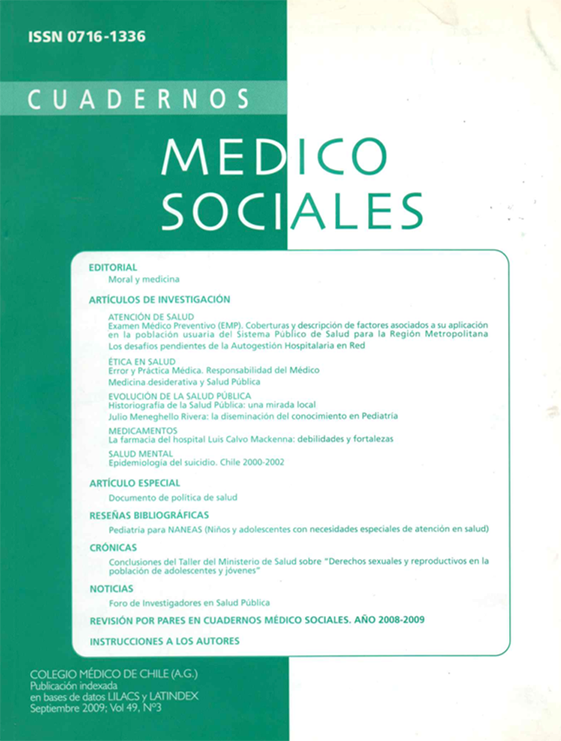Preventive Medical Examination (PME). Coverage and description of factors associated with its application among the users of the Metropolitan Region Public Health System
Keywords:
Preventive Medical Examination, Public Health, coverage rates, factors associated with PME useAbstract
The Preventive Medical Examination (PME) is a periodic health care service provided throughout the life cycle, with the purpose of reducing the morbidity, mortality and disability caused by diseases or conditions that are preventable or controllable, and of detecting risk factors such as smoking, arterial hypertension, alcohol abuse, obesity and physical inactivity. The PME constitutes a right for the whole population, is executed in the Primary Health Care System and has coverage objectives for the population using the Public Health System. The implementation is verified by the Chilean Ministry of Health. OBJECTIVE: To describe the coverage of the PME in adults, ages 20 to 64, carried out in the Metropolitan Region among users of the Public Health System, and to identify factors associated with its use. METHOD: The Ministry of Health’s Monthly Statistic Registers (MSR) of the PMEs carried out in adults, ages 20 to 64, from January of 2006 to December of 2008 were inspected; the number of PMEs in adults carried out in the region and in each territorial Health Service during the study period was ascertained. The corresponding beneficiary population of the Public Health Fund (FONASA) was obtained from the FONASA data bases for the study period. Furthermore, the regional population covered by the Cardiovascular Program was obtained from the MSR. In the calculation of the coverage rates, this last mentioned population was excluded from the denominator in order not to overestimate the beneficiary population. Finally, the relation between the PME and the Medical Consultations in the regional Primary Health Care System was analysed. RESULTS: A total of 788,792 PMEs of adults in the Metropolitan Region was carried out between January 2006 and December 2008. The general PME coverage rate of adults was 11.63%; 11.82% and 12.65% for the years 2006, 2007 and 2008 respectively, with an average coverage of 5.42% for men and of 18.65% for women. On a regional level and during the whole period, the correlation between consultations related to Morbidity and the use of the PME as well as the correlation between consultations related to Health Control and the use of PME were statistically significant (r2= 0.59; p<0.05 y r2= 0.72; p<0.05, respectively). CONCLUSIONS: The coverage of this service in the Metropolitan Region reached the objectives set by the Ministry of Health (Decreto Nº170, metas GES). The different types of coverage depict significant differences by gender, with a male to female ratio of 1 to 4. The use of the PME is seasonally determined, being greater during winter months. There is a statistically significant correlation between Consultations related to Morbidity and PME and a significant correlation between Consultations related to Health Control and PMEs. The conclusions of this study can contribute to the improvement of PME implementation, reveal the importance and enhance the future impact of the PME on the health of the population.
Downloads
Downloads
Published
How to Cite
Issue
Section
License

This work is licensed under a Creative Commons Attribution-NonCommercial-ShareAlike 4.0 International License.


